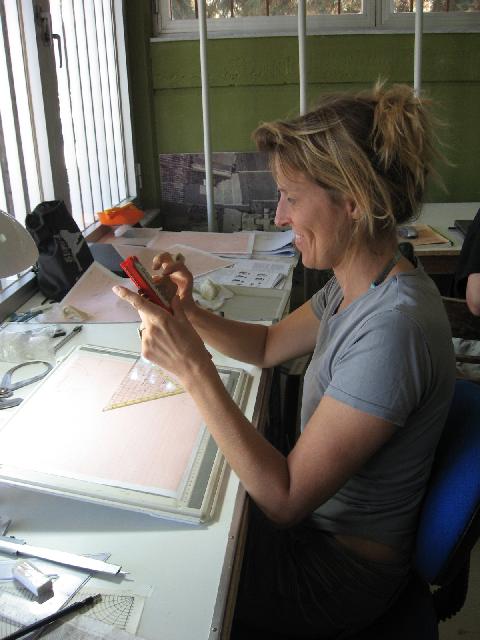I am here in Nemea, the sun is shining and the weather is warm. Every day it has been about 100 degrees.
We’ve been out at the site for the last week, working on laying in a grid in the field for the geologist. That means that we divide the area where we work into square that measure 10 meters by 10 meters. In total, we measure out 20 squares, so that means that we have gridded over 2000 square meters! I really enjoy working in our new field because it is covered in wild thyme, wildflowers, and pine trees.
Don, the geologist, has begun working with the magnetometer (“mag-neh-TOM-eter”) and ground penetrating radar. These are both instruments that geologists and archaeologists use to “map” underneath the earth. The magnetometer measures the differences in magnetic pull of anything under the ground, while the ground penetrating radar sends radio waves through the earth. Both of these can be used with computers to see if there is anything interesting or different happening underneath the ground.
Both weekends have been very busy. Last weekend, there was a religious holiday, and we got to see a procession through the streets of Nemea with priests in gold robes, a band from the local high school, children dressed in traditional costumes, and a religious painting. This Monday was a day off for everyone but us.
Yesterday and today the village of Ancient Nemea is celebrating the New Nemean Games. 2,500 years ago, Greeks from all over the country would come to Nemea and participate in athletic games (running, boxing, throwing, and wrestling) in honor of the god, Zeus. This was an athletic contest that was as important as the Olympics (another athletic game that took place in Olympia, Greece). The people of New Nemea have started to hold races in the stadium at Nemea again. Every four years, people from all over the world come and compete in the same stadium that the ancient Greeks also used. Yesterday, we all got to go and watch the races. There were races for men, women, girls, and boys. They were very exciting! All the runners and referees were dressed like ancient Greeks. There were even some people dressed like Greek warriors! The ancient Greeks also had poetry and playwriting contests as parts of their games. So, tonight we will go and hear some Greek poetry at the Sanctuary of Zeus. To learn more about the Sanctuary of Zeus, the stadium, and the Nemean games, you can look at http://www.brynmawr.edu/collections/nehinterns/AyiaSotira/museum_temple.html and http://www.brynmawr.edu/collections/nehinterns/AyiaSotira/museum_stadium.html.
Our team now consists of about 8 people. The directors (Angus, Mary, and Jim) are here, as well as the geologist (Don) and several students (Ann-Sophie, Jessica, Chris and me). More people will be arriving in the next few days. The full team does not come until July.



